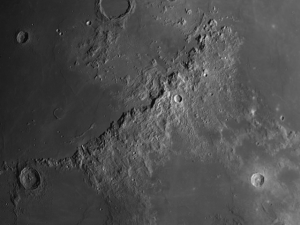The week starting February 29 takes us from lunar Day 21 through Day 27. Moon watchers will have to be early morning observers this week as the Moon rises just before midnight on the 28th and on each successive morning it rises about 50 minutes later.
 March 1st provides you with spectacular sights and is worth staying up for. This week we will highlight the Apennine mountains.
March 1st provides you with spectacular sights and is worth staying up for. This week we will highlight the Apennine mountains.
The Apennine Mountain Range: The Most Spectacular Feature on the Moon
 Montes Apenninus: [NW/H9-G10] The Apennine Mountain Range was formed when the Imbrium basin was blasted out nearly four billion years ago. Mountain ranges on the Earth take millions of years to form. The magnificent ranges that surround Mare Imbrium were created in a matter of minutes! They resulted from the shock waves that exploded out from the original Imbrium impact. The Apennines stretch out over 370 miles and include more than 3,000 peaks. The highest peak in this range is Mons Huygens [NW/G9] which stretches, from its base to its top, to an incredible 18,000 feet!
Montes Apenninus: [NW/H9-G10] The Apennine Mountain Range was formed when the Imbrium basin was blasted out nearly four billion years ago. Mountain ranges on the Earth take millions of years to form. The magnificent ranges that surround Mare Imbrium were created in a matter of minutes! They resulted from the shock waves that exploded out from the original Imbrium impact. The Apennines stretch out over 370 miles and include more than 3,000 peaks. The highest peak in this range is Mons Huygens [NW/G9] which stretches, from its base to its top, to an incredible 18,000 feet!
======================
It is highly recommended that you get a copy of Sky and Telescope’s Field Map of the Moon, the very finest Moon map available for use at the telescope. It is available for $10.95 at www.skyandtelescope.com and on Amazon. All features mentioned in this blog will be keyed to the grid on the Field Map and will look like this: Plato: [NW/D9]
Credits:
Courtesy of Gray Photography of Corpus Christi, Texas
Lunar photos: NASA / USGS / BMDO / LROC / ASU / DLR / LOLA / Moon Globe. Used by permission
- Rupes Cauchy: A Best Known Fault on the Moon - July 22, 2024
- Moon Crater Schickard – Crater Floor has Stripes - July 15, 2024
- Moon Craters Langrenus and Vandelinus - July 8, 2024